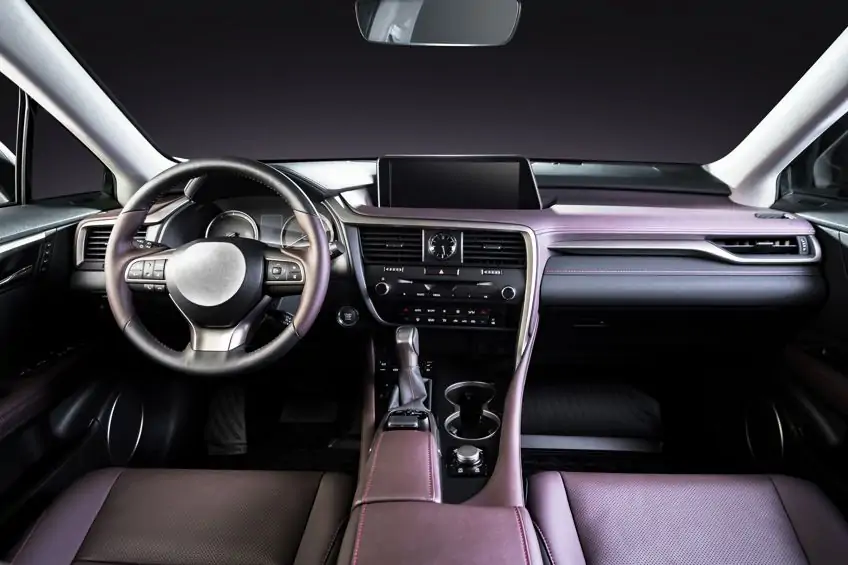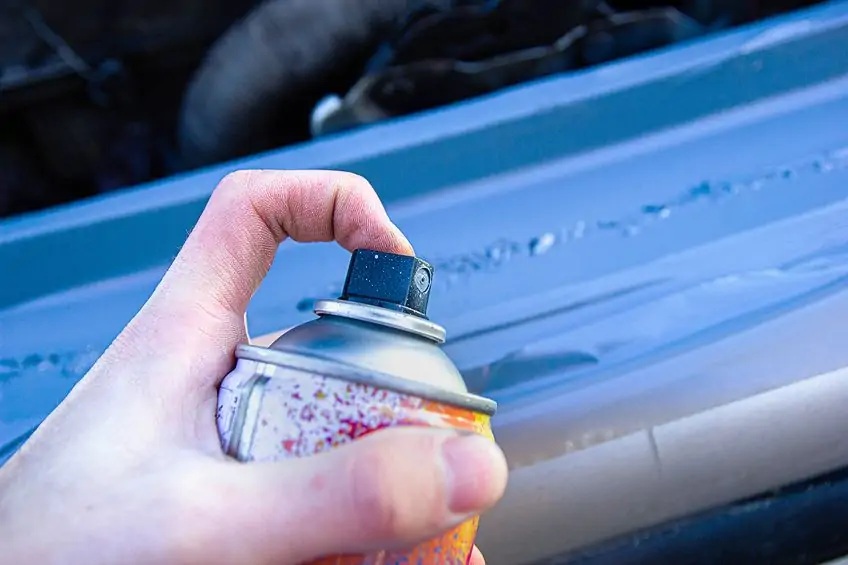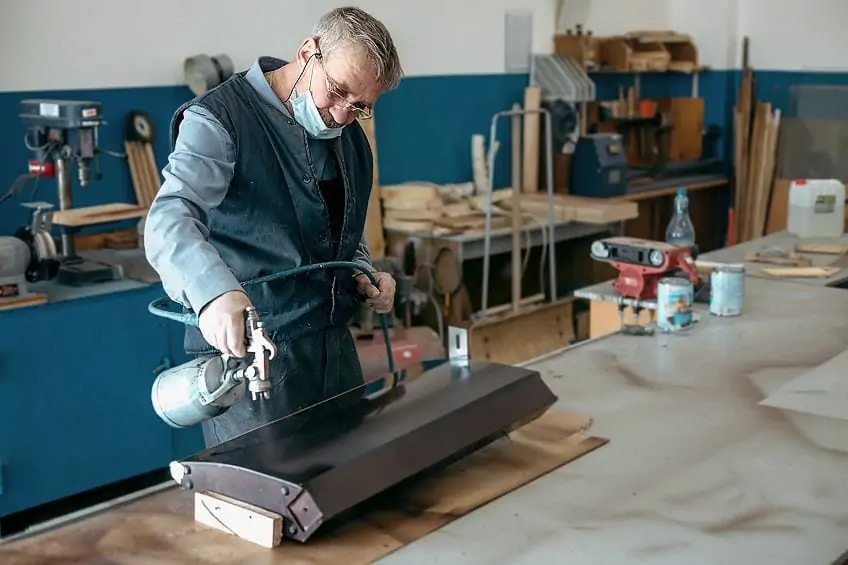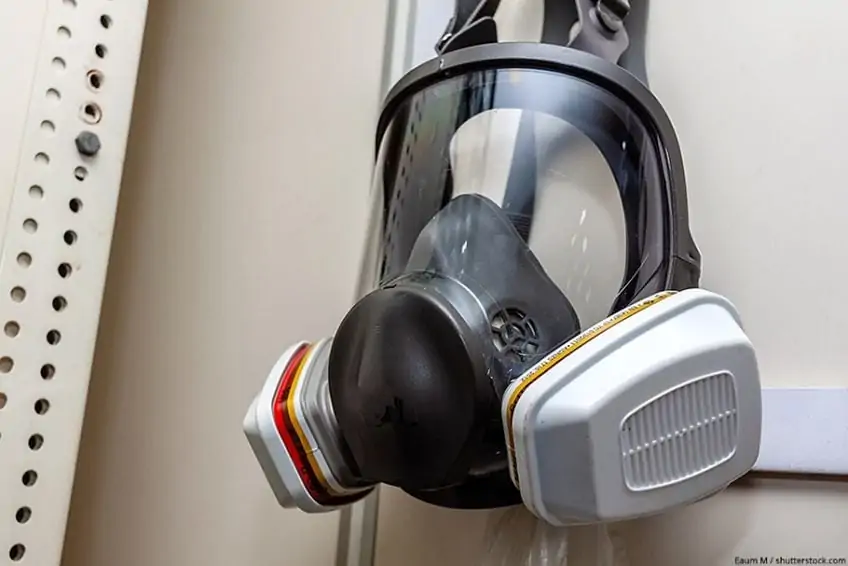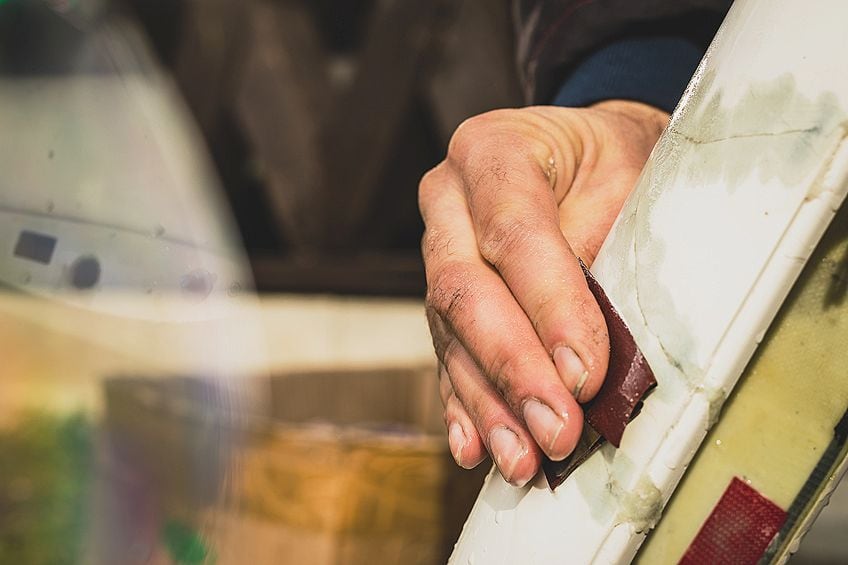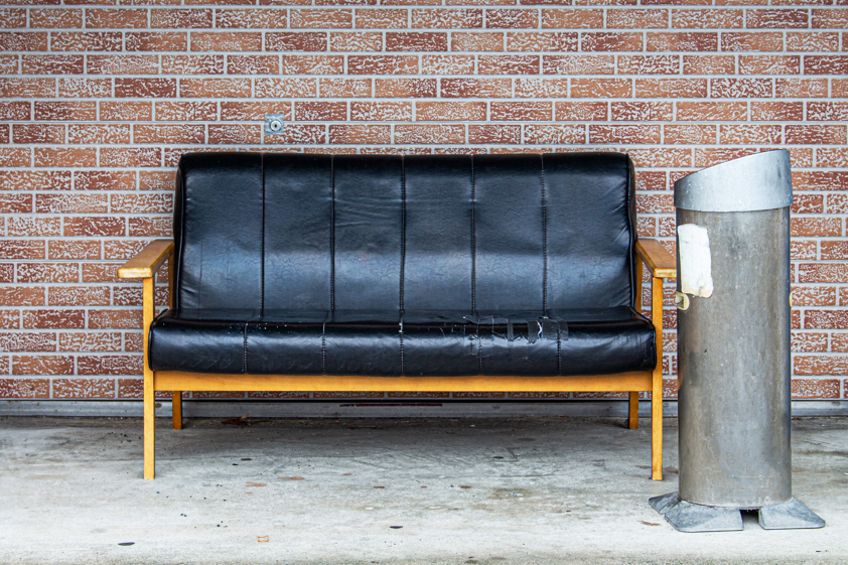Best Spray Paint for Vinyl – Different Types of Vinyl Paint
This post may contain affiliate links. We may earn a small commission from purchases made through them, at no additional cost to you. You help to support resin-expert.com
Do you remember LPs? It seems that in an age where we get our music instantaneously this medium has fallen behind, lost to the ages like 8-tracks and cassettes. The things that set LPs apart from modern media (as most people agree) is the feel. The feel of these records has never been replicated by any modern medium, and this unique texture can be attributed to a material known as vinyl. What is vinyl though? Where does it come from? Can you paint it? Let’s have a look at these and other questions surrounding this revolutionary material.
Table of Contents
What Is Vinyl?
Vinyl is actually shorthand for a material known as polyvinyl chloride. You might also know it as a material commonly called PVC which is used all across the world for various applications but primarily in the construction industry. PVC piping has revolutionized our lives by providing a robust cost-effective solution to lead and/or copper piping. Metal piping was the go-to material in the golden age of construction since the world was still rich with minerals, but there are few drawbacks when using metals in environments with wildly varying temperatures.
The metal expands and contracts when exposed to heat and cold, causing them to crack or burst during the winter months. These metals could also be subject to corrosion and other deterioration, this is where PVC piping comes into play, PVC will gladly expand and contract regardless of most conditions, not to mention that it has strong resilience to impact and abrasion.
PVP is not just used for water piping though. Many installation contractors use PVC to protect electrical wiring underground and in-home attics. PVC is perfect for this application because it dissipates heat and moisture easily and will prevent things like insects and rodents from chewing away at your home’s wiring. Its durability also means that it will likely last the lifetime of your home without cracking or caving in (it is not used to ensure structural integrity though).
Another common usage for PVC in the construction industry is window framing. In the past, window frames were created from wood or steel which we know is subject to corrosion and decay, however, PVC has none of these constraints which has made it commonplace when installing window frames for new homes or even when renovating old homes to be more environmentally friendly.
The presence of this substance increases the longevity of infrastructure, and thanks to PVC being one of the most versatile substances on earth it has seen use in the medical industry, mass production, crafting, automotive aesthetics, home improvement, and even furniture manufacturing.
PVC is also highly customizable since it is pliable in some of the forms we mentioned above and allows the paint to adhere to it with relative ease. There are preferred types of paint and primer to use on vinyl as some base substances of paint are simply not designed to adhere to plastic, so for your convenience, we have created a guide detailing which paints can be used on vinyl and PVC in general. Enjoy!
Different Types of Spray Paint for Use on Vinyl
Acrylic and latex paints are almost unanimously agreed to best option when working with vinyl. Why do you ask? Well vinyl tends to expand and contract, and since the paint coating has to adhere to the fibers of the vinyl the paint can’t be too rigid once dried or it will crack and expose the raw vinyl underneath.
This is why acrylic, latex, or a combination of the two are considered to be the best spray paint for vinyl. If you can’t get your hands on some acrylic or latex paint you can get away with using an enamel paint that has been graded for use with vinyl, this type of paint has the rigidity to fixability ratio necessary for vinyl coating, and in rare instances can even be used on carbon fiber surfaces in a pinch.
| Type of paint | Does it work on vinyl? | Attributes |
| Enamel | ✔ | ● Thick
● Pasty ● Water-resistant |
| Acrylic | ✔ | ● Thick
● Mildly pasty ● Water-resistant |
| Latex | ✔ | ● Medium thickness
● Pasty ● Water and heat resistant |
| Chalk | ✔ | ● Thin
● Thick & viscous ● Water and heat resistant |
What Is the Best Spray Paint for Vinyl?
There are certain characteristics that your vinyl paint has to have in order for it to be effective on your workpiece. This being said, not all vinyl paints are equal in their adhesion and quality, and it pays to get one that works the best for your particular application. Let’s have a look at some of the best spray paint for vinyl on the market today.
Best Overall: RUST-OLEUM Vinyl Spray
Rust-Oleum is one of those brands that have been around since the advent of the wheel, and this is illustrated perfectly when you see the quality of the finish their paints produce. This particular product from the Rust-Oleum team is no different, the 11 oz white paint for vinyl, is perfect for restoring your aged furniture, outdoor boarding, car interiors, office chairs, and even your sports equipment. What makes this paint so effective is that it contains actual vinyl particles that help it adhere to the surface of your choosing, making the paints exiting flexibility and resistance to damage even greater!
- Ideal for vinyl surfaces including luggage, and car and boat seats
- Made with vinyl paint resins making it flexible as the vinyl
- Durable paint provides permanent color to any vinyl surface
Waiting for any paint to dry can feel like an eternity, fortunately, once you are done applying your final coat Rust-Oleum will only have you waiting roughly ten to fifteen minutes before you can move on to the next project or apply some sealer. These hits don’t stop there, this paint is highly resistant to friction, abrasion, and impact, so while it may not be bulletproof it certainly won’t be phased by the odd scratch and bump you throw at it. The icing on the cake, and what makes this (one of) the best spray paint for plastic, has to be its finish.
The white (vaguely ivory) color hue will leave you speechless with its smooth glossy finish which leaves surfaces looking like they were freshly minted a few moments ago, and you have the peace of mind knowing that the quality of this finish will last for the lifetime of your workpiece.
PROS
- Fast-drying in only 15 minutes
- Great surface adherence
- Flexible and durable
- Smooth and glossy finish
CONS
- It is unforgiving, making mistake rectification difficult
- May need several cans for large projects
Best Adhesion: SEM PAINTS Satin Black Color Coat Aerosol
Since we seem to be discussing what the best spray paint for plastic is, we would be remiss not to mention the SEM brand of spray paint products. You see, most brands of paint that claim they work on vinyl only do as a by-product of their base formula, SEM on the other hand sells a wide range of coating specifically designed to work on vinyl and plastic surfaces! With a wide range of products aimed at automotive interiors, you know that this vinyl paint won’t be coming off with the slightest nick of your car keys or greasy fingertips. What really sets this product apart from others in its class has to be an elastomeric coating.
- Excellent for vinyl surfaces, plastic, carpets, and velour surfaces
- The elastomeric coating gives superior flexibility and adhesion
- Suitable for fixing small scratches and spots of damage
As we covered previously, PVC products, and by extension vinyl surfaces, expand and contract according to ambient temperature, therefore what this coating does is ensure that coating is far more flexible than others in its class by increasing its elasticity and adhesion to the surface. Essentially while other vinyl spray paint products do an OK job coating most surfaces, the SEM range of spray paints specializes in ensuring that your vinyl surfaces are coated and protected for what is virtually the lifetime of your workpiece.
You don’t just have to use this vinyl spray paint bare surfaces either, as SEM products can be used to spot repair damaged or scratched surfaces by matching the color and ensuring a seamless aesthetic all around. While this might arguably be the highest quality vinyl spray paint on the market today it is also one of the most expensive ones out there, but you definitely get what you pay for considering the quality of this black spray paint particularly and the longevity of its adhesion.
PROS
- Specifically designed for vinyl surfaces
- The coating is very flexible with increased elasticity
- Suitable for spot repair damage and scratches
- Long-lasting durability
CONS
- Not as durable as other options
- The nozzle could be smoother and more effective
- Quite expensive
Best Value: DUPLI-COLOR Flat Black High-Performance Vinyl and Fabric Spray
Who says that you have to pay an arm and a leg to get some good paint for vinyl? Dupli-Color is another legacy brand that has proven its quality and reliability over the course of many years in the industry. This high-performance black variant does an incredible job of adhering to both vinyl and plastic, so even though it isn’t a specialty project in the same sense that the SEM brands are it still does a great job of adhering and protecting vinyl. Like most brands of spray paint in its class, it does an incredible job of protecting surfaces and has the added benefit of having a similar formula to both the Rust-Oleum and the SEM brand of products.
- The self-priming formula allows for easy and fast repairs for vinyl
- The paint dries to be extremely flexible and durable
- The vinyl paint produces a glossy finish
It has an ultra-elastic base which allows it to retain adhesion while not compromising on flexibility when bonded to the surface of your workpiece. This means that you can bend and fold your vinyl workpiece without your Dupli-Color coating coming apart. One of the key benefits of this product is that in addition to providing a high-quality finish it is also self-priming, this means that if you are working on a time-sensitive project the Dupli-Color team has got you covered.
This also means you save some money on having to find a primer that works on vinyl, which can be fairly pricey especially if you will be purchasing from a reputable brand. A major selling point for this particular brand is that it is relatively inexpensive for a product that is both self-priming, easy to use, provides increased flexibility, and provides a high-quality finish. This is a product that might appeal to you if you only need paint for vinyl for a once-off project, and one that will do the job fairly well.
PROS
- Self-priming
- High-quality finish
- Increased flexibility
CONS
- You need to prepare the surface before
- Fairly pricey
How to Spray Paint Vinyl Surfaces
There are a few things you should know before you paint a vinyl surface. If this will be your first time here is a tutorial detailing how to clean, prime, paint, and seal your workpiece. It is a fairly straightforward process but having to remove paint from vinyl is tricky so it’s best to be 100% sure of the task ahead before you begin. It is always a good idea to use safety equipment like a mask when using aerosol paints.
Prepare Your Surface
The preparation phase is extremely important when you are working on painting a vinyl workpiece. Vinyl has a habit of attracting mold and dust as it becomes positively charged by friction fairly easily, this is why you will notice the vinyl blinds and car interiors live glove boxes and dashboards become dusty quickly. If you are painting an exterior wall you might notice things like little bits of mold or moss growing between the slats, and it is the combination of both dust and these particulates that can negatively affect the adhesion of your paint.
The best way to clean your workpiece before applying your vinyl spray paint is to simply use some soapy water to get rid of these particles. You will find yourself having an easier job cleaning an exterior vinyl wall than a smaller piece of furniture or car interior because you will have the option of using a pressure washer.
Simply pop your soapy solution into your pressure washer’s reservoir, point, and shoot. When dealing with smaller objects like furniture and car interiors you can use some soapy water and a cloth, and for really stubborn stains you can use a scrubbing brush to get rid of those nasty stains. Allow your workpiece to dry completely before taking the next step.
Prime Your Surface
This is the step that counts. Priming any surface for any paint is extremely important and will ensure that your paint adheres well to your surface. Once you are sure that your surface is completely dry, use a dry cloth and wipe it off one more time to ensure that there are no residual particles attached to it after the drying process. Once you are sure that your surface is clear, get your primer and check the manufacturer’s instructions regarding whether it needs to be mixed or shaken before usage. Before you get spraying you should lay down a tarp or some old newspaper on the floor to ensure your workspace isn’t ruined by paint.
A good tip is to scuff up your surface with some fine-grit sandpaper to help with the adhesion process. Once you have it slightly roughed up, you should wipe off any material that has been ripped away during this process. It is time to get priming! Give your can a final shake and make clean, uninterrupted passes over the surface you are going to spray, make sure that you don’t miss any corners or equally tricky bits that you will be painting later.
Once you are done, apply your first coat let it dry for the time advised by the manufacturer. Then, once dried, inspect the surface to ensure there are no particles present on the workpiece – if there are, simply wipe them off. Once you are sure that your workpiece is clean, apply the second coat of primer and allow time for it to dry before you move on to the next step.
Paint Your Surface
There’s a trick to painting vinyl as opposed to painting things like wood or fabrics. Once you are sure that your primer is dried and ready to go, make sure that you cover up any open spaces that you won’t be painting with some painters’ tape (if it’s furniture, make sure to cover up the legs and exposed beading that might fall victim to paint) and get your paint ready.
Once you are sure there are no particles on your primer (if there are wipe them down with a dry cloth) you can start painting. Ensure that you start by spraying off the workpiece and make the pass in your desired direction. If you are spraying with a flat workpiece the optimal way to spray is a horizontal motion, or simply from left to right and vice versa.
If you are spraying more intricate workpieces you should spray in whichever position is best suited to getting the best results, even if it means getting on your back or your hands and knees.
The key to getting good results when painting vinyl fabric is to make quick and even passes with your spray can, this is because it pays to do multiple light coats instead of two or three even/heavy coats when working with this medium. Ensure that you allow for the recommended amount of time for the paint to dry before you go for your next coat, in doing so you will also be able to see how your vinyl spray paint color of choice changes in intensity while you are spraying. You should feel free to apply as many coats as you feel necessary until you achieve your desired finish.
Tips and Tricks When Spraying Vinyl
Here are some tips and tricks you can use to ensure that your next vinyl workpiece has the best finish. Remember that half the work when painting vinyl fabric is in the preparation and having patience with your workpiece.
Choosing A Color
Choosing a color can be a craftsman’s worst nightmare, especially with the sheer variety of paint available. Choosing vinyl spray paint colors will require you to take lots of things into consideration. One of these is where your workpiece will be situated and the colors that will be surrounding it. You might notice that the color you choose can appear weak when you start spraying, but this is not the case.
As we mentioned previously when you are spraying a vinyl workpiece you will have to do multiple light coats instead of fewer even ones.
This will allow you to manage the intensity of the color and see how it fits in its intended environment. If you are spraying decals for your car, or even furniture it’s a good idea to ensure that the color does not clash with any existing elements as it’s tricky to get spray paint off the vinyl.
Preparing Your Workspace
It should go without saying that whether you are using an aerosol can spray paint or using a paint sprayer you should ensure that you are working in a well-ventilated environment. Remember, pain that is graded to work on vinyl has additives that ensure adhesion and flexibility, which can make them slightly more dangerous than regular types of spray paint.
Inhaling these particles can cause serious discomfort so ensure that you always wear a mask even if you are working outdoors. We mentioned previously that you should put down a tarp on an equivalent floor covering when working with spraying paint on vinyl, however ensuring that you cover up parts of the workpiece that you do not want to paint is equally as important.
Vinyl is typically used as a front-facing or covering material, this means that it is often attached to things that are more robust and not made of vinyl, so covering up these parts of your workpiece should become second nature when working with this material.
Lastly, ensure that you set up your workspace in such a manner that you would have to look for things once you have started painting. A good example is placing things on the side of your dominant hand, if you are right-handed, place things such as your paint, primer, rags, and sandpaper on your right-hand side so you won’t be caught off guard if you need to catch some runoff.
Now that you know what vinyl is, its different applications in our lives, which paints work on it, how to spray paint it, and have some pro tips, it’s time for you to get out there and put your newfound knowledge to the test. Remember to always work in a well-ventilated environment, ensure that you pick the right color for your workpiece, and spray numerous light coats. Whatever you are painting, ensure you wear the appropriate personal protection gear, and overall put your safety first!
Frequently Asked Questions
Can You Spray Paint Vinyl?
Yes. What most people might not realize is that vinyl is essentially a processed plastic, therefore most spray paints that work on plastic should also work on vinyl. If you don’t mind the price, you could also use fabric paint on your vinyl workpiece!
What Kind of Paint Will Stick to Vinyl?
Most types of paint that stick to plastic will stick to vinyl as well, paints like enamel, acrylic, and latex paints do especially well when used on vinyl. Some of these paints may have a water base which allows them to seep in and adhere to the vinyl much easier than paints of the thicker consistency.
How Do You Get Paint To Stick to Vinyl?
Preparation is key! Ensure that your workpiece has been cleaned and is free of debris. Once it has been cleaned you have the option of sanding very lightly, but this is not really a requirement. Prime your workpiece with a primer that is formulated for vinyl paint. Apply numerous light coatings of vinyl spray paint to your workpiece, allowing for time for each coating to dry in-between coatings.


